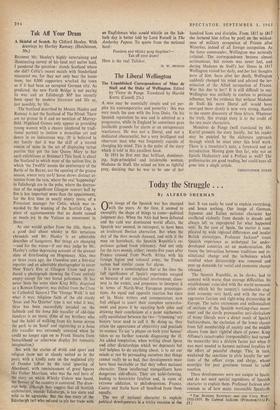The Liberal Wellington
The Unpublished Correspondence of Mme de StaEl and the Duke of Wellington. Edited by Victor de Pange. Translated by Harold Kurtz. (Cassell, 25s.)
A MAN may be essentially simple and yet per- plex his contemporaries and posterity: this was very much the case with the Iron Duke. On his Spanish reputation he was and is admired as a progressive, while in England he sometimes gave justifiable grounds for alarm as an unregenerate reactionary. He was not a liberal, and not a dedicated obscurantist, but a very intelligent and observant man who was frequently capable of changing his mind. This is the point of the story which is told in this excellent book.
In 1814 he first met that brilliant, domineer- ing, high-principled and intolerable woman, Madame de Stael. She seized on him as rightful prey, deciding that he was to be one of her hundred lions and disciples. From 1815 to 1817 she lectured him (often by post) on the wicked- ness of military occupation of France after Waterloo, indeed of all foreign occupation. As the force commander, Wellington was naturally irritated. The correspondence became almost acrimonious, but esteem was never lost, and during Madame de Stael's last illness in 1817 Wellington visited her daily, and her last thoughts were of him. Soon after her death, Wellington suddenly changed his mind and advised the ter- mination of the Allied occupation of France. Was this due to her? It is still difficult to say.. Wellington was unlikely to confess to petticoat influence, but the evidence that without MadaMe de Stael his more liberal self would have emerged more slowly is now very strong, thank's to the recent discovery of these letters. Whatever the truth, this strange story is to the credit of the two main characters.
Monsieur de Pange (well translated by Mr. Kurtz) presents the story lucidly, but his reader may be puzzled by the elaborate approach through which he must enter this brief work. There is a translator's note, a foreword and an introduction. Having gone thus far, why not an Epistle Dedicatory and a Preface as well? The preliminaries are good reading, but could have all gone into a single article.
CHRISTOPHER SYKES






























 Previous page
Previous page